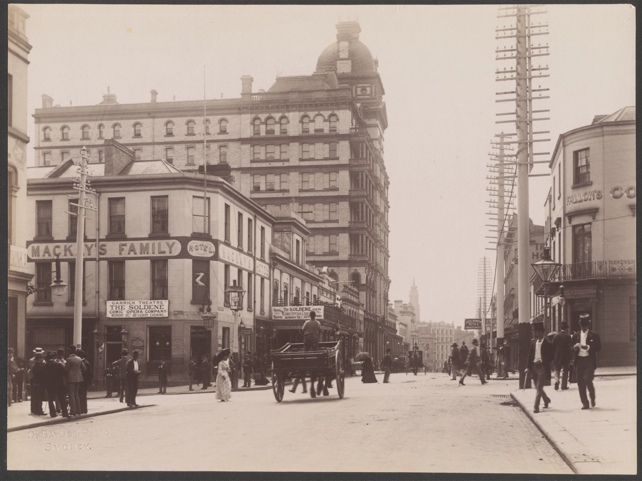Resource Sheet 1
George Street
There is nothing to differentiate George Street, Sydney, from one of the principal thoroughfares of York, or Liverpool, or Exeter, but the brighter aspect of the buildings and the warm and lustrous quality of the air. The highway is full of omnibuses, coaches, private carriages, cabs, drays and waggons. The pavement is alive with foot passengers; and the shop windows display the latest fashions in jewellery and dress, the newest books and engravings, the freshest designs in furniture and ironmongery, and the most recent novelty in quack medicines.
Extract from HM Franklyn, A Glance at Australia in 1880, Victorian Review Publishing Company, Melbourne, 1881.
A stranger from America
Sydney has a population of 400,000. When a stranger from America steps ashore there, the first thing that strikes him is that the place is eight or nine times as large as he was expecting it to be; and the next thing that strikes him is that it is an English city with American trimmings… The Australians did not seem to me to differ noticeably from Americans, either in dress, carriage, ways, pronunciation, inflections, or general appearance. There were fleeting and subtle suggestions of their English origin, but these were not pronounced enough, as a rule, to catch one’s attention. The people have easy and cordial manners from the beginning—from the moment that the introduction is completed.
Extract from Mark Twain, Following the Equator, 15 September 1895, American Publishing Company, New York, 1897.
Castlereagh Street, Sydney c1890

Garrick Theatre on Castlereagh Street looking north, Sydney, New South Wales, Charles Bayliss, National Library of Australia, nla. pic-vn4217920.
The Drover’s Wife (extract) by Henry Lawson
The “house” contains two rooms; is built of round timber, slabs, and stringy-bark, and floored with split slabs. A big bark kitchen stands at the end, and is larger than the house itself, veranda included. Bush all round—bush with no horizon, for the country is flat. No ranges in the distance. The bush consists of stunted, rotten “native apple-trees.” No undergrowth. Nothing to relieve the eye, save the darker green of a few she-oaks which are sighing above the narrow, almost waterless creek. Nineteen miles to the nearest sign of civilisation—a shanty on the main road.
The drover—an ex-squatter—is away with sheep. His wife and children are left here alone.
Four ragged, dried-up-looking children are playing about the house. Suddenly one of them yells: “Snake! Mother, here’s a snake!”
The gaunt, sun-browned bushwoman darts from the kitchen, snatches “the baby” from the ground, holds it on her left hip, and reaches for a stick…
It is near sunset, and a thunderstorm is coming. The children must be brought inside. She will not take them into the house, for she knows the snake is there, and may at any moment come up through the cracks in the rough slab floor. So she carries several armfuls of firewood into the kitchen, and then takes the children there. The kitchen has “no floor”, or, rather an earthen one called a “ground floor” in this part of the bush. There is a large, roughly-made table in the centre of the place. She brings the children in and makes them get on this table. They are two boys and two girls—mere babies. She gives them some supper, and then, before it gets dark, she goes into the house, and snatches up some pillows and bed-clothes—expecting to see or lay her hand on the snake any minute. She makes a bed on the kitchen-table for the children and sits down beside it to watch all night.
The Bulletin, 23 July 1892.